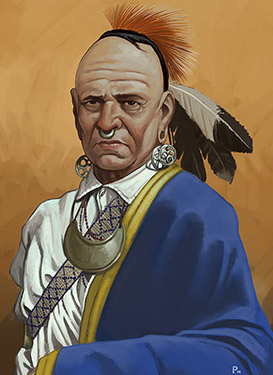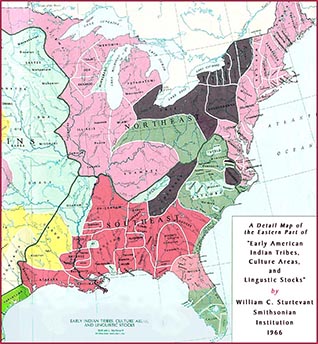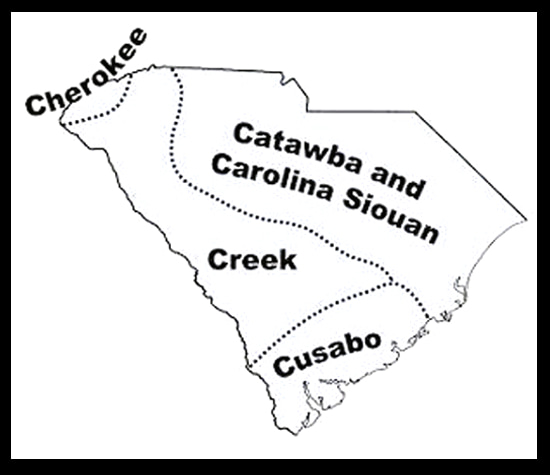We are Proud of our Past
The Catawba Indians have lived on their ancestral lands along the banks of the Catawba River dating back at least 6000 years. Before contact with the Europeans it is believed that the Nation inhabited most of the Piedmont area of South Carolina, North Carolina and parts of Virginia. Early colonial estimates of the Catawba population when settlers arrived are between 15,000-25,000.
Early Catawbas lived in villages which were surrounded by a wooden palisade or wall. There was a large council house in the village as well as a sweat lodge, homes, and an open plaza for meetings, games, and dances. The homes were rounded on top and made of bark. The dwellings were small with extended families living in a single structure. Catawbas were farmers. They planted crops like corn and squash along the banks of the river. They also fished and hunted. The Catawbas were a large and powerful group and waged war with neighboring tribes, especially the Cherokee.
First contact with the Catawbas was recorded in 1540 when the Spanish explorer Hernando de Soto marched his troops through the Piedmont while headed west looking for gold. There was little contact between the Nation and early settlers because the new colonies were barely surviving. Once the Virginia colony of Jamestown and the Carolina colony of Charles Town became more established this changed.
The tribal people called themselves yeh is-WAH h’reh, meaning “people of the river.” The colonists who came to trade began calling all the tribes along the Catawba River Valley by the name Catawba. By the late 17th century, trade began having a major impact on the Catawba society. The Catawba traded deerskins to the Europeans for goods such as muskets, knives, kettles and cloth. The Catawba villages became a major hub in the trade system between the Virginia traders and the Carolina traders.
Settlers began to move into the Piedmont during the 18th century. The Nation always carried a philosophy of brotherly love and peace when it came to the settlers. This did not serve them well though because the settlers brought disease with them. In 1759, smallpox swept through the Catawba villages for a fourth time in a century bringing the population of the Nation to less than 1,000 by 1760. Colonists believed the Nation was dying out.
Catawba warriors were known as the fiercest in the land. The Nation claimed at least eleven other tribes as enemies. Leaders of the state of South Carolina knew this and kept relations with the Nation friendly. King Hagler was chief from 1750 to 1763. He is remembered as a friend to the English but also a firm defender of the rights of his people. The Nation’s friendship with the English helped both sides. The colonist received protection from other tribes that may try to threaten them and the Nation received supplies that aided in their survival. During the Revolutionary War, the Catawba aligned with the patriots and fought with them against England to help them gain their independence. In 1763 the Catawbas received title to 144,000 acres from the King of England. It was hard for the Nation to protect the land from colonists and eventually they began renting land to settlers. The first tenant was Thomas Spratt who leased several thousand acres of farmland.
Eventually the settlers who had leased land from the Nation wanted the land for themselves. They put pressure on South Carolina to negotiate with the Nation. This was during the Removal Period when many tribes were being moved west. In order to avoid this, the Nation and South Carolina negotiated the Treaty at Nations Ford. The treaty stipulated that the Catawbas relinquish to the State of South Carolina their 144,000 acres of land. In return, South Carolina promised the Nation a new tract of land in a less populated area and to pay the Catawbas money. By 1847, South Carolina Governor David Johnson said, "They are, in effect, dissolved." However, that was not the end of the Catawbas.
References: Merrell, James. The Catawbas. New York: Chelsea House Publishers, 1989.
Our Heritage
The Catawba have long understood the need to work together and adapt to our ever-changing circumstances. No one knew this better than King Hagler who led the tribe from 1754-1763. He adopted the title of King because the settlers coming into Catawba territory at the time were led by a king.
King Hagler (1754-1763) was a powerful ally to the English and was well respected among the Piedmont tribes. He led the Catawba people to side with the English in the French and Indian War. He also protected the local settlers against Cherokee invaders. He firmly believed in the treaties that were created to protect his people, and when traveling to negotiate the documents, he took the principal Warriors with him. Even though King Hagler wanted to preserve the lands of the Catawba, he also understood that survival depended on working together.
That heritage has been passed on through many generations since King Hagler. We fought along the side of the Patriots when the settlers decided they wanted to be free from England, one of only three tribes to do so. George Washington’s journals mention the fierceness of the Catawba Warriors many times and how valuable they were to the effort.
When other tribes were being moved west on the Trail of Tears, the state of South Carolina decided not to spend the money because the tribe membership was so low in numbers at the time that it was expected the Catawba would be extinct soon. That warrior spirit and resiliency of the Catawba have helped us through many hard times.
After our federal status was removed in 1951, we reorganized and fought to regain that status. And though it took over 20 years to accomplish this, we achieved it. That same heritage is within the tribe now. We are warriors and are a strong, resilient people, who know that working together will move us farther down the path we want to go.

Our Lands
The ancestral lands of the Catawba Nation extend through the Piedmont region of North and South Carolina and into southern Virginia. We have lived on these lands along the Catawba River for thousands of years.
The warpaths created over the years intersected within the Catawba lands. Once settlers arrived, these paths became trade routes with the Catawba lands along The Great Trading Path. The Catawba Nation became an essential stop on the route from Jamestown to Charlestown (now Charleston). The Catawba became skilled traders which allowed them to acquire weapons, tools, blankets, and cloth in exchange for furs and other wares like Catawba pottery. Catawba bowls and pots became a sought-after commodity for the settlers due to their quality.
The number of settlers continued to grow, and the Catawba lands were reduced dramatically from the 144,000 acres granted to us by the King of England to the 700-acre reservation now held in trust for the Nation. We still live on our beautiful ancestral lands along the banks of the Catawba river today.
Due to growth and development in our area, we are now close to the thriving city of Rock Hill which is a suburb to the Charlotte metropolitan area. The Nation is a short 30-mile drive from Charlotte Douglas Airport as well as only a 10-minute drive from the I-77 corridor. This provides the Nation with a prime location for growth and development.

Our People
Early counts of the Catawba people made by Spanish explorers estimated the population of the tribe at the time as between 15,000-25,000. After settlers arrived in the area, two rounds of smallpox decimated the tribe’s numbers, and by the early 1800’s, our once large group was down to under 100 citizens.
The Catawba people have endured many changes throughout the years and learned to adapt and evolve with their new surroundings. Traditionally, Catawba communities were matriarchal societies. Catawba women were seen as dominant centers of their communities. Sally New River, the granddaughter of King Hagler, was a landowner that leased land to the Scotch-Irish settlers that were moving into the area. This was unheard of during this period.
The Catawba have learned to survive through the changes around them while also continuing to preserve the most essential parts of our culture. Today, the Catawba citizenship is diverse. We have over 3000 enrolled tribal citizens and continue to grow. We live throughout the United States and have citizens outside of the country, though the majority live on or near our reservation lands.
Our citizens come from many backgrounds and have an array of skills to enhance the labor force. The Catawba still recognize the reservation as their homelands and feel connected to the ancestors that preserved our Nation by living there and passing the land down from generation to generation.

Catawba Today
Of the 573 federally recognized tribes in the United States, the Catawba Indian Nation is the only one located in the state of South Carolina. The modern day tribal lands are located in York County, South Carolina. There are currently over 3300 enrolled members of the Nation. The Nation has a long history and a rich culture that lives on today.
Path to Recognition
During the Franklin Roosevelt administration the federal government tried to improve conditions for tribes. Under the Indian Reorganization Act, the Nation created a constitution in 1944 to help them govern themselves. Government policy toward tribes changed in the 1950's and many tribes were asked to terminate their federal status. In 1959 the Catawba Nation was terminated in the eyes of the federal government. After some time the Nation determined that they preferred to be seen as a community and decided to fight another battle...that to regain federal recognition.
In 1973, the Catawbas filed their petition with Congress for federal recognition. They also updated and adopted their constitution in 1975. The Catawbas had a strong argument in this fight. The Treaty at Nations Ford with South Carolina was illegal because it was not ratified by the federal government. The federal government should have protected the rights of the Nation. It took 20 years, but on November 20, 1993, the land claim settlement with the state of South Carolina and the federal government finally came to an end. The Catawbas agreed to give up claims on land taken from them by the state of South Carolina. In return, the Catawba Indian Nation received federal recognition and $50 million for economic development, education, social services, and land purchases.
Tribal Government Operations
The Catawbas have many thriving programs provided for Nation citizens and the surrounding community. The administrative offices are located on the Reservation. This building houses the Executive Committee of the Nation as well as staff working in departments such as Accounting, Economic Development, Real Estate, Social Services, and Transportation. The administrative office has over 40 employees. The Nation also has a successful housing program, several child care facilities, a seniors program, computer lab, and transit services. There is a clinic on the reservation that is run through Indian Health Services. The Nation has helped support many Nation citizens in their pursuit of an education through the Scholarship and Job Placement & Training programs. The Catawba Cultural Center provides a link to the rich culture of the Nation.
The Nation participates in several York County boards and committees including Economic Development, RFATS, and the Catawba Regional Council of Governments. Nation leaders are always looking for opportunities to contribute to the community through economic development, helping forward the goals of the county, and sharing the culture with others. The Catawbas have proven again and again that they will continue to thrive against all odds.
Catawba Pottery
Our Cultural Legacy
The Catawba people have specific methods they follow to create their pottery. From finding the clay, building the pieces, and burning the pottery they have remained close to the traditional ways with few exceptions being made for technological advances that improve their pottery. Clay for traditional Catawba pottery is dug from clay holes along the banks of the Catawba river. Many of the same clay holes that were used hundreds of years ago are still used today. After the clay is hand processed it is then ready for creating pottery. Catawba pottery is formed completely by hand using several different methods depending on the size of the piece. After the piece is finished, it is left to dry for several days. After it is dry then the potter will begin the detail work by rubbing and scrapping the piece by hand. They use many different tools to do this work from sea shells, smooth rocks from the river, and old snuff cans. Many potters pass their pottery creating tools down to their children and grandchildren. Burnishing or "rubbing" the pots can be a long and tedious process. After the potter is happy with the piece, then it will be fired in an open fire. The potter warms the piece by leaving it outside the fire and then slowly moves it closer and closer until it is put into the fire. The process of firing gives the pottery its distinctive look. The colors come from the clay along with the variety of wood used and the intensity of the fire.
There were several famous Catawba potters who were known for their art. Many of their pieces can be found in museums and in art collections. Even though societal changes led to a decline of pottery making, the tradition has been revived and is still passed down today. About 50 adult Catawbas make and sell pottery on a regular basis. Catawba children are being taught the craft in the children’s programs that are run by the Nation and there are also pottery classes for adults taught at the Cultural Center with hopes of keeping the tradition alive.
Due to the importance of pottery in the Catawba culture the Nation is committed to making sure that there are always Catawba potters to teach this skill to others so that this 4,000 year old tradition can continue to be passed on to future generations.
References:
Hilton Pond Center. “The Catawba Indians: People of the River.” Hilton Pond Center for Piedmont Natural History. http://www.hiltonpond.org/CatawbaIndiansMain.html
University of South Carolina Lancaster, “Native American Studies” USC Lancaster, http://usclancaster.sc.edu/NAS/ (accessed October 24, 2012).

